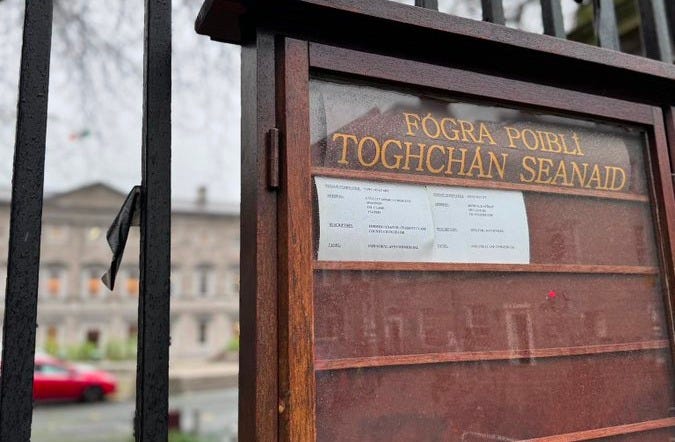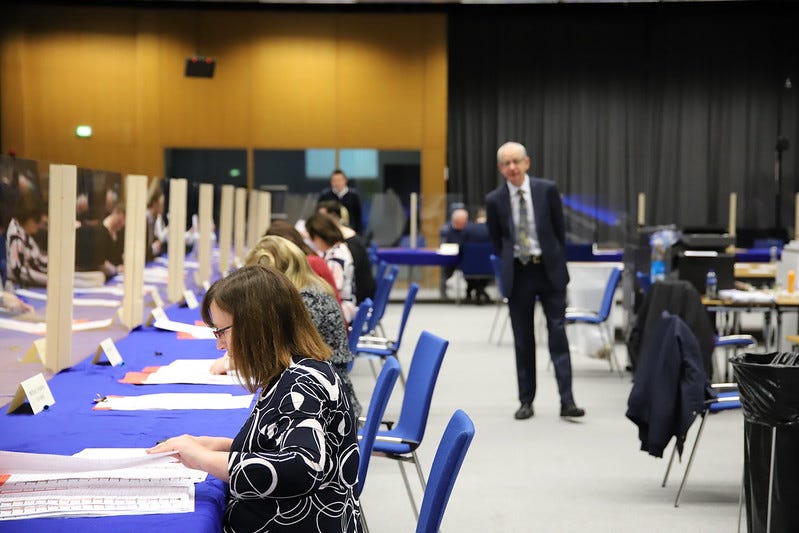Everything You Didn't Know, And Frankly Weren't Interested Enough To Ask, About the Seanad Elections
Buckle up, nerds: you're about to learn about sub-panels.

This was originally posted as a thread on X and Bluesky but, after a few suggestions that I post it somewhere less ephemeral, here it is.
It often passes under the public radar - for understandable reason - but within 90 days of a general election being called, there’s also an election to Seanad Éireann, the upper house of the Irish parliament.
Why is this understandable? Because the vast majority of the public don’t get a vote, and an election they can’t vote in, passes them by. Only a fraction of the general public gets to vote, and even then, it’s only for a fraction of the seats.
The Seanad? What’s that?

You might have heard of it being sometimes referred to as ‘the Senate’, and their names are interchangeable.
The big issue with the Seanad is the fact that it’s not supposed to mimic the work of the Dáil, and yet it is largely composed of people who want to get into the Dáil and so are intent to mimic the work of a TD.
In principle, the Seanad is supposed to act as a bit of a counterbalance to the Dáil, and ensure that the law-making work of directly-elected TDs is scrutinised by a second parallel chamber of vocational experts and learned academics. This is reflected in how the Seanad is made up:
Six members are elected by university graduates; three by the University of Dublin (which has only one constituent college, Trinity College) and three by the National University of Ireland (composed of UCC, UCD, Galway, Maynooth and a few other associated institutions). The election of January 2025 marks the last election under the present format; the next election will have a single six-seat constituency in which graduates from all Irish third-level bodies can vote.
11 members are nominated by the Taoiseach. Whoever is elected Taoiseach by the new Dáil – most likely, at the present time, to be Micheál Martin – gets to hand-pick the remaining members. This measure is designed to avoid any Washington-style logjam where the two parliamentary chambers are controlled by two different blocs: giving the Taoiseach the right to hand-pick 11 senators should ensure that the coalition which controls the Dáil also has a majority of votes in the Seanad too.
43 members are elected from ‘vocational panels’, ostensibly representative of five major vocational fields. The only voters in these elections are members of the new Dáil, members of the outgoing Seanad itself, and the 949 members of county and city councils. The exclusionary nature of this electorate, amounting to 0.031% of the Dáil voting pool, is largely the reason why the Seanad has become a plaything of political parties.

Vocational Panels? What are they?
This gets to the nub of the election. These 43 seats are split among five panels, effectively running as five parallel constituencies:
Labour (11 seats)
Industry & Commercial (9 seats)
Agriculture (11 seats)
Cultural & Educational (5 seats), and
Administrative (7 seats).
These panels are constructed so that recognised not-for-profit bodies in those fields - e.g. the Irish Farmers’ Association in the agricultural panel; the Irish Congress of Trade Unions in the labour panel; Comhaltas Ceoltoirí Éireann on the cultural panel - can nominate candidates and put them forward for election.
(You may remember a controversy in 2014, when Fine Gael appointed a man to the board of the Irish Museum of Modern Art, just days before nominating him as a candidate for a by-election to the Cultural & Educational Panel. The exercise was widely seen as an exercise in inflating the candidate’s credentials so as to meet the threshold for Seanad membership. In truth, it was probably unnecessary: although a judge of the High Court acts as a referee, the thresholds can be met relatively simply. Getting onto the Cultural & Educational Panel could be as simple as being a longstanding GAA club officer.)
However, that’s not the only way to get nominated; it’s also possible for four Oireachtas members (including those of the outgoing Seanad; it is not ‘dissolved’ in the same way as the Dáil is, and remains in situ until the new one is elected) to sign nomination papers and to put candidates forward too.
Inside each panel, therefore, there are two sub-panels: the Oireachtas subpanel (known informally as the ‘inside panel’, because candidates are nominated by people inside the Leinster House gates) and the nominating bodies subpanel (the ‘outside panel’).

This creates knock-on complications for the process of electing them. All candidates end up on the same ballot paper, no matter how they were nominated, but there is a quota of how many candidates must come from each of the two sub-panels. In the 7 and 9-seaters, for example, a minimum of three must come from each.
This means the Seanad elections throw up a rare – and possibly unparalleled –possibility of a candidate being beaten for the final seat by a rival with fewer votes.
Who could win a seat in a fudge like this?
The pre-defined and exclusive nature of the Seanad electorate means many candidates and parties will start out knowing pretty much exactly how many seats they can win.
That’s because only TDs, councillors and outgoing senators can vote in the vocational panels, and the party affiliation or loyalty of all those people is pretty transparent. At the time of writing there are 174 TDs, 47 senators (there are 13 vacancies in the outgoing chamber, mostly because of senators becoming TDs) and 949 councillors - a total electorate of 1,170.
Take Fianna Fáil, which has 48 TDs, 16 outgoing senators, and 248 councillors - 312 voters. That’s a little over a quarter of the total electorate, meaning Fianna Fáil have enough votes to contend for four of the 11 seats on the Labour and Agricultural panels, and so on. By comparison, the Green Party goes in with 29 voters, which isn’t nearly enough to compete. (Smaller like-minded parties sometimes arrange voting pacts to pool their strength; the Greens might stand a chance if they collaborate with the Social Democrats, 46 votes. Their collective 75 votes could yield one seat each on the bigger panels.)
The challenge for the bigger parties is in managing this vote effectively - which also includes stopping too many candidates from getting nominated in the first place. This isn’t easy to control, given that candidates can be put forward by outside bodies. In 2020, no fewer than 16 Fine Gael candidates ended up contesting the Industrial & Commercial Panel, which only elects 9 senators to begin with. Fortuitously for the party’s sake, many of those candidates were no-hopers and the electorate rallied around some frontrunners, but the party only took two seats when it could have expected three.
There is still, nonetheless, competition for seats. Some candidates always get nominated from outside; some always from inside. There are always more candidates from one party, than the party has votes to elect. Hence, there is canvassing, which usually entails candidates driving the length and breadth of the country trying to press the flesh with as many councillor partymates as they can.
This time around, the canvassing will coincide with the Christmas holidays, which frankly is far from ideal. One candidate put it to me that they’d be knocking on doors in the days between Christmas and New Year’s Day, often arriving to a councillor’s house while their in-laws were there. (Some councillors might be happy at this, using their political visitor as a buffer.)
Party headquarters will also give the nod to some preferred candidates, on the basis that they might make good TDs in future. Is there a constituency where the incumbent TD is getting on in years, and who might retire at the next election? Was there a candidate who missed out on a seat because of poor vote management? Headquarters will encourage councillors to support a candidate who they think could make a good TD in future, and who would benefit from a few years of exposure and prominence by being in Leinster House.
Break out the Smarties again, Gav: how does the count work?
Whoa, boy. There are not enough Smarties in the world.
Simply put: the electoral system for the Seanad is basically the same as for a Dáil election. The two University panels are counted just as if they were three-seat Dáil elections, with surpluses and eliminations just the same.
The same principles apply for the vocational panel, with one exception: every ballot paper is treated as if it was one thousand separate, identical ballot papers.

People sometimes suspect this is to give Seanad elections a veneer of respectability, making it look like there are millions of voters. This is not the case.
The reason is that, when the electorate is so small, the surpluses can be tiny, and the choice of which ballot paper to treat as the surplus ends up being really important.
Imagine a (very small) Dáil election where the quota is 98 and someone wins 150 votes. In a Dáil election, you’d go through all 150 ballot papers, look at the second preferences listed on every single ballot paper, and then distribute the 52 ‘spares’ in which every candidate got the commensurate share of number 2s - thus trying to remove any sense of randomness and making sure that the surplus is representative of the entire pile. The problem with this is, how do you know that the number 3s on that surplus are also representative of the whole pile? Or the number 4s or 5s?
In a Dáil election the margins are relatively large and it’s unlikely that the random selection of ballot papers will skew the race. But in the Seanad, where the number of voters is relatively small and almost everyone casts a good few preferences, the randomness cannot be tolerated. What if the quota is 98, and someone gets 99 votes? That’s a plausible scenario. Choosing one ballot paper out of 99, over another, might have a real consequence for who gets elected.

To go back to the Smarties analogy: instead of picking out one red Smartie as a surplus (as in a Dáil election), you can effectively take one-seventh out of each of the seven Smarties and pass them on collectively, to ensure that the surplus is more representative of the vote as a whole.
And so, every Seanad ballot paper is treated as if it were 1,000 votes - so that, instead of picking one ballot paper out of 99, you pick 1,000 ballots out of 99,000 and pass them onwards. Effectively, you’re redistributing a fraction of every ballot paper.
Does all of this mean you can lose and still win?
Yes. Some candidates who run in the vocational panels, and lose, will still end up being chosen as a Taoiseach’s nominee anyway.
And some of those defeated candidates in vocational panels, will also have lost in the general election.
But, the systems works as it is intended. Timmy Dooley lost his Dáil seat in 2020, and was unsuccessful in contesting the Industrial & Commercial Panel. But, Micheál Martin knew that on a better day there could be two Fianna Fáil Dáil seats in Clare, so Dooley was made a Taoiseach’s nominee, kept his national status, and was returned to the Dáil alongside Cathal Crowe two weeks ago.
When do we know what’s happening?
Nominations for the two University panels have already closed - the TCD candidates are here, and the NUI ones are here.
Nominations for the ‘outside panel’ close on December 18th – which is also the day of the new Dáil’s first meeting – while the inside panel is closed on December 31st.
All Seanad elections are conducted by registered post, with the polls closing on the morning of January 30th, and all counts beginning as soon as possible thereafter.
Oh, and one more thing…
Fine Gael currently has 294 voters for the Seanad (38 TDs, 245 councillors and 11 outgoing Senators), but it’s within Simon Harris’s gift to manufacture three more.
Three of the outgoing Taoiseach’s Nominees - Timmy Dooley, Erin McGreehan and Emer Currie - have become TDs, and the outgoing Taoiseach still retains the right to hand-pick three replacements who immediately become members of the outgoing Seanad.
Even though that Seanad is not scheduled to meet, its new members would retain all the privileges of Oireachtas members - the lifelong right to saunter into Leinster House, to visit the members’ bar and restaurant, and to park on the premises.
And, in this instance, to vote in the forthcoming Seanad elections. It might only be three votes, but in these races, every vote counts.




Great article